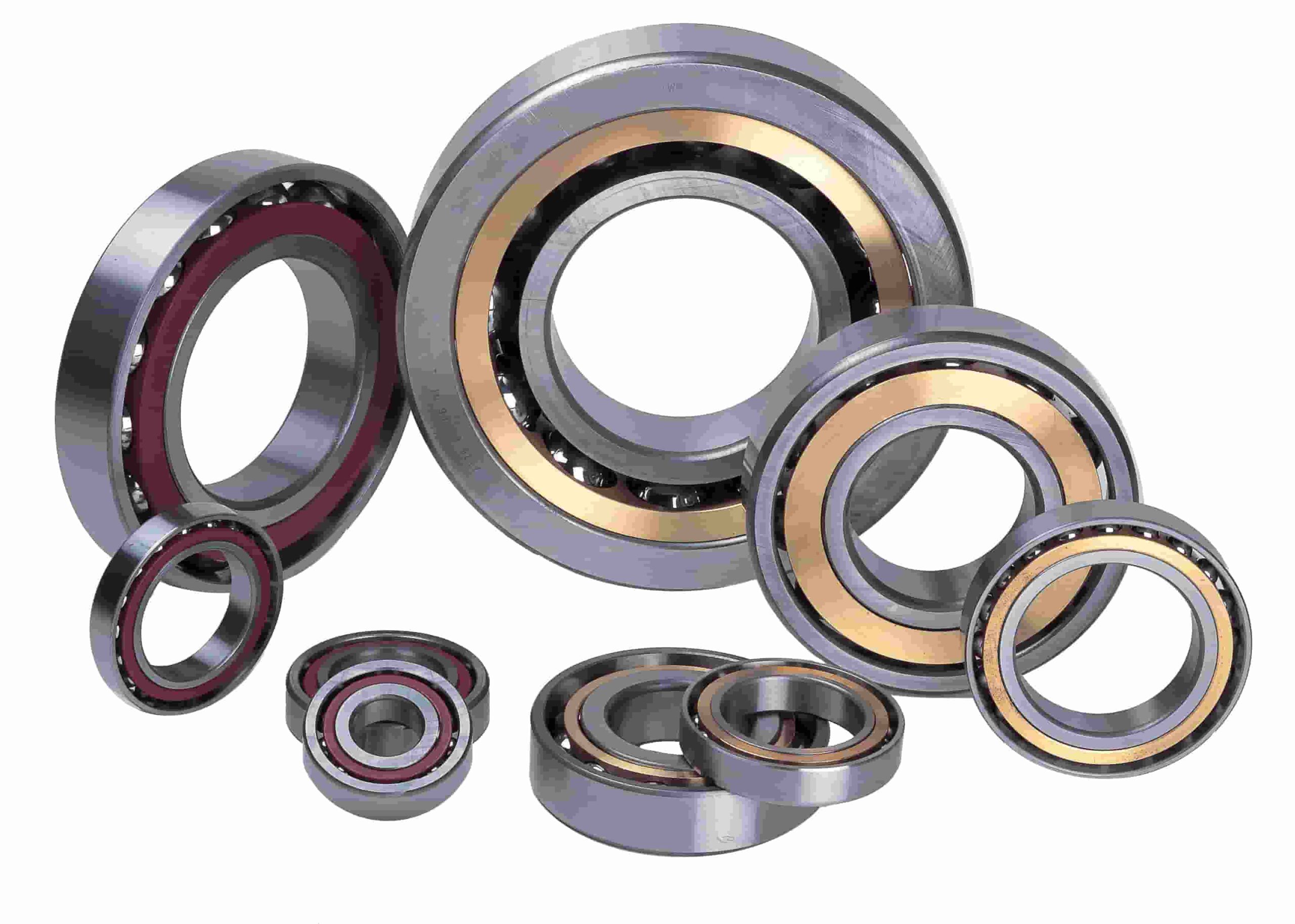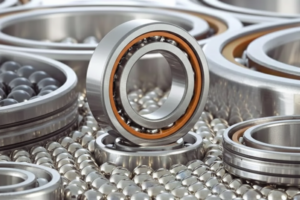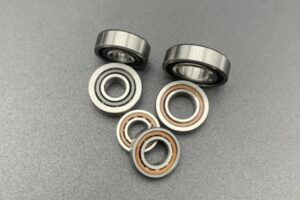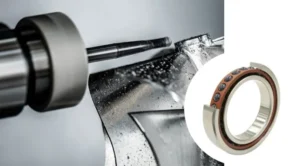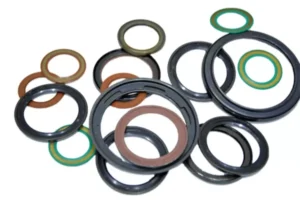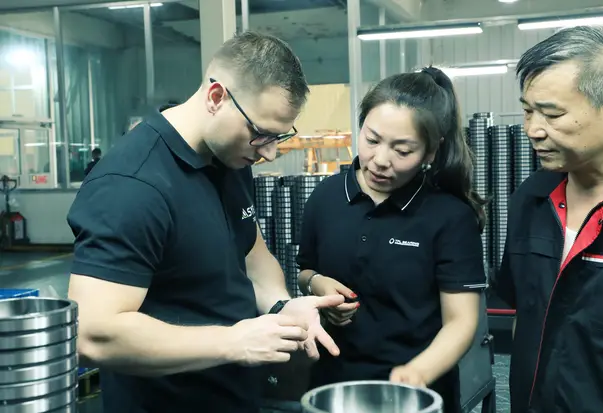Introduction
Ever wonder how things like your bike wheels, car parts, or even big machines spin so smoothly, even when they’re getting pushed from the side? A lot of the time, the secret heroes doing that job are called Angular Contact Ball Bearings.
They might sound complicated, but they’re actually pretty cool once you get to know them. This guide will give you the lowdown on what they are, why they’re special, and where you might find them working hard behind the scenes. Let’s jump in!
What Makes an Angular Contact Ball Bearing Different?
Alright, so you might already know about regular ball bearings. They help parts spin or rotate with less friction. Imagine spinning a fidget spinner—that smooth movement happens thanks to tiny bearings inside.
But angular contact ball bearings? They take it up a notch.
Here’s what makes them different: they can handle force that comes at an angle—not just straight down. Most regular bearings are made to deal with radial loads (that’s the force from up and down or spinning). But angular contact bearings can also deal with axial loads, which are forces that push from the side or at a slant.
This is a big deal when machines have parts that move in more than one direction or have to stay super steady while spinning fast.
So if something spins and gets pushed around from the side (like a car wheel going around a corner), angular contact bearings are what keep things working properly.

Difference Between Angular Contact Bearings And Deep Groove Ball Bearings
A deep groove ball bearing is like the basic model—it’s got a deep track where the balls sit nice and straight. If you sliced it open and looked at the cross-section, that track runs parallel to the axis (the center line of the spinning part). It’s perfect for regular spinning stuff, like a skateboard wheel or a fan, but it’s not the best at handling forces pushing from the side.
An angular contact ball bearing, though? It’s different in how it’s built. The balls are tilted—like they’re leaning a little. When you check out the cross-section, the track they roll in isn’t straight; it’s angled one way, making an angle (called α) with the axis or the line perpendicular to it. That tilt lets it take on side forces and straight-on pressure at the same time. So, it’s tougher and better for trickier jobs, like in car wheels or machines where things push from weird angles.

Why the “Contact Angle” Matters
Alright, let us discuss this “contact angle.” Simply said, those balls we discussed have a tilt. The angle alters the functioning of the bearing. For quick-rotating objects like a bike wheel, a small angle—say, 15°—is great. For heavy stresses, such as those found in an automobile engine, a larger angle—say 40°—is better.
On a bearing you could find codes like “7205B.” That “B” at the very last? It’s telling you the angle—here, it’s 40°. Simple codes like that help you pick the right one for the job!
Types of Angular Contact Ball Bearings
Single Row vs. Double Row Angular Structures
Just like deep groove bearings, these angular contact bearings also come in different row configurations based on their structure:
- Single Row Angular Contact Bearings: These have just one row of balls. Because of their angled design, they are excellent for handling heavy axial load in one direction only. You have to install them facing the right way for the load!
- Double Row Angular Contact Bearings: These are like having two single-row bearings built together into one unit, usually looking like they are arranged back-to-back. This double row ball bearing structure contains two rows of balls and can handle strong axial loads from either direction. They are wider than single-row types.
- Four-Point Contact: These are a bit different. They are built to manage forces acting in all directions. Imagine a box pushed from either side; these bearings can manage that!

Pairing Up: Putting Angular Contact Bearings Together
Single row angular contact bearings, as we discussed previously, usually only handle end push in one direction. However, these bearings are often used in pairs since you may have pushes coming from both sides of you. For this reason, these bearings are frequently utilized in pairs!
Face-to-face (DF): They face each other. This also helps with forces from both directions but in a different way.
Back-to-back (DB): They face away from each other. This is good for handling forces from both directions.
Tandem (DT): They face the same way. This is for when there’s a really strong force in just one direction, and you need extra support.
Universal Pairing (DU): Bearings are pre-matched by the manufacturer for any of the above configurations, ensuring interchangeability during installation.

Angular contact bearings have a specific side that needs to face a certain way (we say they “recognize a face”), they often have a special mark on the outside ring. These could be little V-shaped arrows, lines, or other symbols. Always look for these marks and follow them – it makes sure the angular bearing pair works correctly and doesn’t wear out too fast. It’s like having little instructions printed right on the bearing!

Materials Used in Angular Contact Bearings
What are these bearings made of? Well, they need to be strong and last a long time, so they’re usually made of tough stuff. Here are some common materials:
- Steel: Strong and reasonably priced, this is a somewhat common material. The required bearing toughness will determine the kind of steel to employ.
- Stainless Steel: If the bearing is going to be around water or other things that could cause rust, stainless steel is a good choice because it doesn’t rust easily.
- Ceramics: Sometimes, the balls inside the bearing are made of ceramic. Ceramic is very hard and can help the bearing spin faster and last longer in certain situations.

Where You’ll Find Angular Contact Bearings
Where are these helpful bearings concealed, then? They are used where both sideways (axial) and spinning (radial) forces must be handled, frequently at respectable speeds. Among the instances are:
- Car and Truck Wheels: Especially front wheels that have to deal with cornering forces.
- Gearboxes and Transmissions: Lots of gears push sideways as they turn.
- Pumps and Compressors: Parts inside these often experience axial thrust.
- Electric Motors: Especially motors that have sideways loads on their shafts.
- Machine Tools: Things like lathes and milling machines need very precise and stiff bearings to make accurate cuts – ACBBs are perfect here.
- High-End Bicycle Hubs: Some performance bike hubs use them for smooth rolling and handling side loads during turns or sprints.
Basically, anywhere you need more than just simple spinning support, an ACBB might be the right choice!
Conclusion
So there you have it! Angular Contact Ball Bearings aren’t so mysterious after all. They’re special bearings designed to handle forces coming from the side (axial loads) as well as straight down (radial loads). The key is their “contact angle,” which changes how they balance speed and load handling.
You’ll find them working hard in single rows, double rows, or pairs in all sorts of machines you use or see every day. They’re one of those important little parts that make a big difference in keeping things running smoothly and reliably.
FAQs
What’s the biggest difference between a regular ball bearing and an angular contact one?
The biggest difference is that angular contact ball bearings are specifically designed to handle sideways pushes (axial loads) much better than regular ball bearings, thanks to their internal shape and contact angle. Regular bearings are mostly for straight-down (radial) loads.
Can I just use one single-row ACBB by itself?
You can, but only if the sideways push is always in one specific direction. If the push can come from either side, you usually need to use two single-row ACBBs paired together (like back-to-back or face-to-face) or use a double-row ACBB.
What does the contact angle actually do?
The contact angle changes how the bearing handles loads. A bigger angle lets it take more sideways (axial) push, while a smaller angle is usually better for higher speeds. It directs the load through the balls at a specific angle.
Why are they sometimes used in pairs?
Because a single bearing might only be good at handling force in one direction. Pairing them up lets them handle force from both ways.
How do I know which contact angle to choose?
It depends on the job. For light loads, go with a smaller angle (like 15 degrees). For heavier loads, pick a bigger angle (like 25 degrees).
